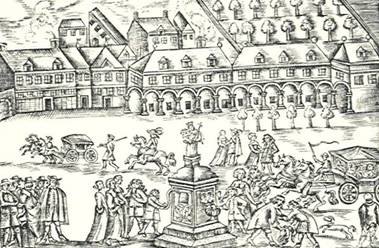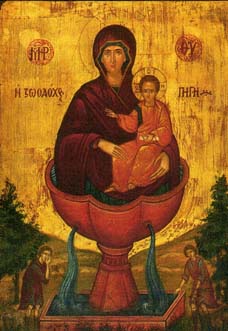Fountains and Marian Pilgrimage Places
Fountains and Marian Pilgrimage Places
Marian Pilgrimage Places Associated With Fountains or Wells
— Sister M. Danielle Peters

During the Middle Ages it was customary to erect Marian wayside shrines close to springs or wells which had proven to have healing power. On one hand this happened in order to teach the people that indeed their prayers are heard and on the other hand to avoid idolatry. Following are some examples from various countries.
The magistrate of the city of Aachen, Germany, erected the above-pictured ‘Mary Fountain’ in the year 1650 with three openings giving way to sulfur water.[1] A legend is connected to the Triberg Spring in Germany. In 1644 a girl found a parchment with painting of the Immaculate Conception near a spring. Many sick people, especially those suffering from ailments of the eye were cured from its waters. In gratitude a wayside shrine and eventually a church were built.[2] Similar shrines were erected in Austria in the eleventh century, ‘Mariabrunn’, in the seventeenth century in Putleinsdorf, in 1626 in Leobersdorf, in 1644 Mariabrunnental. The story of Mariabrunn in Vienna relates that Blessed Gisela, a sister of Henry II, found a statue of Mary made of linden wood into a well. In 1477, vandals threw this statue back in the well and it took until 1490 before it was recovered and placed in a little chapel dedicated in Mary’s honor.In Westroosebeke, Belgium, a shrine dedicated to Our Lady in 1400 AD is famous for its fountain water, which is especially effective for the cure of eyes.
In France too, Mary Fountains are known, which are mainly employed for the cure of sicknesses related to the eye as in Notre Dame de la Fontaine Sainte and Notre Dame de Marceille from 1010 AD. A plaque at the fountain reads: Mille mali species Virgo levavit aqua (This Virgin has relieved thousands of ailments through this water). In 1133 a spring was discovered in Font Nomen upon which a church was built. The water flows into a basin underneath the church where the faithful can wash themselves before they enter the church. The main feast day of this fountain church is the birthday of Our Lady, September 8.[3] Around 1370 AD the picture of Grace Notre Dame de Clarn was rescued from a well. The same happened already in the ninth or tenth century to the statue of Notre Dame de Villethiou in the diocese of Blois.[4] In Lannemezan, France, Mary appeared to an eleven-year-old girl asking her to have a church built. When this was realized in 1537 there was a tremendous number of healings recorded from the spring flowing there, so that in 1626 a new and larger church had to be constructed.[5] In 1013 at Notre Dame de Baudouan, close to Chartres, a shepherd found an image of Mary close to a spring, which he brought to the parish church. However, twice the image returned to the spring. Eventually a church was built with seven doors in order to regulate the tremendous numbers of pilgrims. A fountain eventually was built to enclose the spring so that the people could more easily drink the healing water.[6]
In Poczajow, Poland, Mary appeared to a hermit. A spring developed at the very spot where she stood. In 1559 a Greek bishop enthroned a painting from Constantinople at the site and in 1648 a church was built there.[7]
In Russia two pictures of Our Lady have been found in Surbegi (1530) and in Kiev (1500). Both have been rescued from the waters of a spring.[8]
Nuestra Señora de la Fuencisla, Spain, was found in 1019. Supposedly, the statue originated in Antioch from where St. Peter sent it to Spain in 64 AD. In 714 it had to be hidden from enemies and was found again in 1019. The statue was in excellent condition, still dressed with garments customary at the time of the Blessed Virgin Mary.[9] Allegedly, St. Peter sent another statue of Our Lady similar to the one from Antioch, which was carved by Nicodemus and painted by St. Luke, to Madrid, Spain. In 720 it had to be hidden in a well from where angels rescued it and brought it to a field where shepherds found it in 1242. Repeatedly, the statue returned to the well via a path of accumulated clouds. Eventually, a spring developed close to the site and a small church with the name ‘Wells of living water’ was built there.[10] In the thirteenth century Nuestra Señora de la Franquerra, Spain, was found on a rock next to a healing spring.[11]
In Guacare, Venezuela, Our Lady of Tomoroto appeared to an Indian chief by a spring requesting that he and his people would be baptized. The people came with burning torches to the spring and washed themselves in the water.[12]
In the thirteenth century devotion started at a spring in Matarieh by Cairo where the Holy Family is assumed to have stayed while on their flight to Egypt.[13]
Similar to the Life Giving Fountain in the East, we observe a vivid popular devotion to places where physical miracles are obtained through the intercession of the Blessed Virgin Mary. Apparently, Our Lady employs the same strategy as her Son who first took care of physical needs before he offered spiritual healing. It is stunning how many of these healing waters were specifically efficacious in terms of ailments of the eye. Once relieved from their bodily blindness or shortsightedness, these fountains may also have helped to cleanse the spiritual vision of faith of the pilgrims.

[1] Stephan Beissel S.J. Wallfahrten zu unserer Lieben Frau in Legende und Geschichte. Freiburg 1913, p.21f.
[2] Ibid. p.341.
[3]A. J. M. Hamon, Notre dame de France, Histoire du culte de la sainteVierge en France par M.le Curé de Saint sulpice I, Paris 1861, p. 335ff.
[4] See Tolra de Bordas, Le pélerinage de Font-Romeu, Perpignam 1855.
[5] Stephan Beissel S.J. Wallfahrten zu unserer Lieben Frau in Legende und Geschichte. Freiburg 1913, p.428.
[6] A. J. M. Hamon, Notre dame de France, Histoire du culte de la sainteVierge en France par M.le Curé de Saint sulpice I, Paris 1861, p. 71f.
[7] Ibid. p.394.
[8] Stephan Beissel S.J. Wallfahrten zu unserer Lieben Frau in Legende und Geschichte. Freiburg 1913, p.24.
[9] Ibid. p.469.
[10] Ibid. p.474f.
[11] Ibid. p. 456.
[12] Ibid. p.481.
[13] P.M.Julien S.J. Der Muttergottesbaum in Matarieh, Regensburg 1906. See also: Otto F. Meinardus, Das Heilige Land--Aud den Spuren Marias von Nazareth, Frankfurt, 1998.
All About Mary includes a variety of content, much of which reflects the expertise, interpretations and opinions of the individual authors and not necessarily of the Marian Library or the University of Dayton. Please share feedback or suggestions with marianlibrary@udayton.edu.
